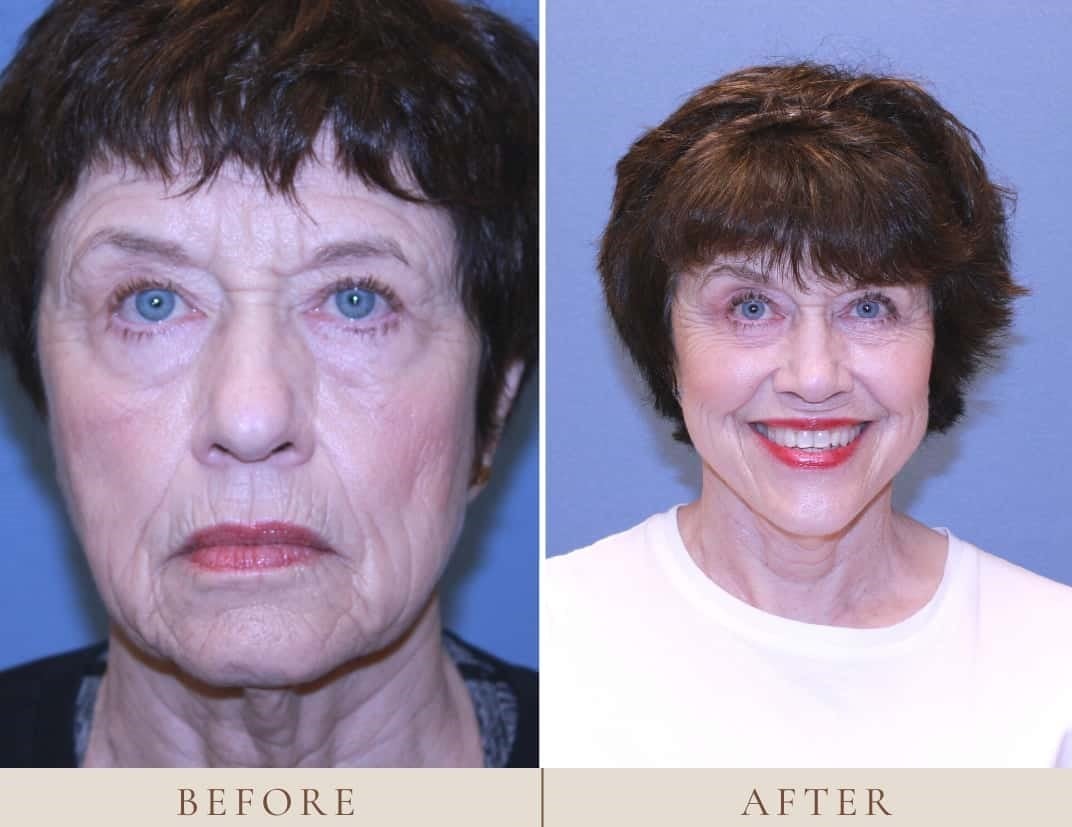Facelift (Rhytidectomy) Procedure in Houston: Types, Costs, and Recovery
In 2016, in the U.S., 13,702 men and 107,261 women had facelift surgery, according to The American Society for Aesthetic Plastic Surgery. It was the fifth most prevailing aesthetic surgery type among men.
If you live in Houston and are thinking to yourself, "I need a facelift near me", you're in luck since many cosmetic surgeons provide services for a facelift in Houston. Still, you should gain some knowledge of the procedure and what to expect in terms of what it is, the different types, costs and recovery.
Before and After Facelift Photos

What Is a Facelift (Rhytidectomy)?
If you're not sure what a facelift is, here's probably the best facelift (rhytidectomy) definition.
The clinical term for facelift is rhytidectomy. It's a cosmetic surgery procedure with the goal of providing you with a more youthful-looking face. The surgeon removes extra facial skin to reshape the lower half of your face.
As you age, there are alterations in the shape and appearance of your face due to normal age-related changes. You have less elasticity in your skin and it becomes looser. In some areas of your face, fat deposits decrease, while in others they increase.
Rhytidectomy enhances noticeable signs of aging in your neck and face, such as:
- Fold lines become deep between the corner of your mouth and your nose
- Facial skin relaxation causing sagging
- Development of jowls in your jaw and cheeks
- Fat that's disappeared or fallen
- Excess fat and loose skin of your neck that can look like "turkey neck" or a double chin
You can lose the youthful contours of your face due to various factors, including:
- Loss of facial fat
- Thinning of your skin
- Smoking
- Gravity
- Stress
- Sun damage
- Heredity
Rhytidectomy is typically performed on an outpatient basis. It might involve sedatives, local anesthetics or general anesthesia. It could take anywhere from two to five hours and you typically go home the same day as your procedure.
The best candidates for rhytidectomy are individuals who show facial aging signs described above, but still have some elasticity in their skin. Typically, this includes individuals in their 40s to 70s.
It’s essential you’re in good mental and physical health and you have expectations that are realistic. rhytidectomy isn’t designed for altering your appearance completely or making you look like a totally different person. It’s a way of “shedding a few years off your face” and restoring your once-younger appearance. But, it’s not a treatment for solving psychological or personal problems.
You should consider and discuss the following points with your cosmetic surgeon before undergoing a facelift:
- Rhytidectomy isn’t recommended if you have a serious health condition.
- You’re at a greater risk of complications if you have diabetes or high blood pressure.
- Tobacco use and cigarette smoking increase your risk of complications following your procedure. It can interfere with the healing process.
- Good bone structure and skin elasticity will provide the best results.
- You shouldn’t take blood thinners or aspirin for a minimum of one week before your procedure.
Request a Consultation for a Facelift Today in Three Locations in Houston!
Clear Lake
Memorial City
Southeast Houston
What are the Different Types of Facelifts
If you're considering having rhytidectomy to restore a youthful look or rejuvenate sagging skin, you might have some confusion about which type of facelift is ideal for you. There are many different types of facelifts, with some popular types being:
-
Traditional Facelift
A traditional facelift addresses aging (moderate to advanced) around your neck and mid-face fully. While a traditional facelift is a more extensive procedure than that for a mini-facelift and you would require more recovery time, your results are more drastic. The cosmetic surgeon makes incisions behind your hairline, hidden in your natural folds, beginning near your temples and working their way around the front of your ear to:
- Remove extra skin to smooth out creases
- Reposition your deep tissues underneath your skin
- Eliminate sagging and jowling skin under your chin
- Restore a youthful, natural face and neck contour
-
Deep Plane Facelift
The deep plane facelift focuses on severe neck and cheek aging. This surgery lifts your skin and muscle tissue to correct neck sagging, heavy cheeks and skin laxity. A deep plane facelift is known for its ability to produce the longest-lasting and most natural-looking facelift results and can yield a rejuvenated and refined look.
In fact, according to research, individuals who have a deep plane facelift look a minimum of five years younger and continue looking better five and a half years following their procedure than they did prior to their procedure. This provides the longest-lasting and best results in facelift surgery.
-
Mini Facelift
The mini facelift, as the name implies, is mainly used for individuals who have fairly low degrees of "jowly" or sagging skin. It's a less invasive procedure, allowing the surgeon to use shallow incisions to tighten your facial tissues.
Generally, they make the incisions along your hairline and above each of your ears. They use the incisions to:
- Correct jaw appearance and size
- Correct sagging skin
- Help you appear more rejuvenated and youthful
A mini facelift requires only soft sedation and local anesthesia. It's a popular procedure since it can keep you from requiring a more advanced facelift procedure for many years. Learn more about the mini facelift in Houston here.
-
Muscle Supporting Facelift
The muscle supporting facelift or SMAS (superficial muscular aponeurotic system) lift impacts your skin's superficial top layers and the deeper tissues of your neck and face. Advancing age and use tend to cause these tissues to sag and grow lax.
The cosmetic surgeon performs a SMAS lift by creating an incision above your hairline at the temple. They then extend the incision downward as they follow the natural crease of your skin at the edge or in front of your ear, below your ear lobe and then behind your ear. Sutures are then used to tighten the muscle supporting facelift. The surgeon removes any extra skin and then stitches up the remaining skin.
You're a good candidate for the SMAS lift if you have mild laxity, mid-face sagging and some jowls. There are a few popular muscle supporting facelift methods. Depending on the method used, you may have some difference in:
- Placement of incisions
- Length of procedure and recovery time
- Overall results
- Revision rates
-
Natural Facelift
Natural Facelift is a totally natural treatment consisting of two parts:
Lymphatic drainage: This focuses on three essential items:
- Draining of the superfluous lymphatic fluid
- Optimizing the natural skin condition
- Stimulating of natural skin hydration
Tonifying (stimulating) techniques: These include:
- Deep tissue massage
- Alternation of extreme effleurages
- Facial techniques
- Light frictions
You can experience a facelift, but in a more natural manner, thanks to combining these techniques. Your skin is more active and highly stimulated, resulting in an amazing rejuvenated result without the need for surgical intervention, allowing you to look much younger, but in a more personal and natural way. It's a relaxing and comforting treatment, leaving your face rejuvenated and firmer.
How Much Does a Facelift Cost?
So, how much is a facelift?
Rhytidectomy, on average, costs between $8,000 and $12,000. Comprehensive facelift costs will include the cost for:
- Anesthesia
- Preparatory tests
- Prescriptions
- Surgical fees
If you're thinking about having rhytidectomy, be sure to sit down with the cosmetic surgeon and discuss the facelift costs associated.
There are certain factors, however, that could affect the facelift cost, including:
- Facelift type: As you've learned, there are numerous types of facelifts, made for addressing specific signs of aging and improving your targeted facial features' appearance. Generally, traditional facelifts will be more expensive than mid or mini facelifts, since the latter treatments involve smaller incisions and are quicker.
- Anesthesia type: You can choose between general and local anesthesia, and typically, local anesthesia will cost less than full sedation. Also, each anesthesiologist will charge their own fee.
- Technique: Advanced techniques, like endoscopic facelifts, for example, might be more expensive than traditional procedures.
- Surgeon's reputation and skill: A cosmetic surgeon with advanced training will likely charge higher prices than those with less experience. Even so, the extra cost is still worth the outstanding surgical results and peace of mind.
- Additional treatments: Many individuals combine other surgical procedures with Rhytidectomy for more thorough results. You should know, these additional costs will likely not be included in the estimate you receive for the initial treatment.
- Location: The cost of your procedure will also depend on where you live, just like the cost of living is different depending on where you live. In larger metropolitan areas, you can probably expect to pay higher fees.
Typically, health insurance doesn't cover rhytidectomy since it's a cosmetic surgery that is optional and usually not because of a medical reason. Therefore, you will need to pay the full cost out-of-pocket.
Where are Facelift Incisions Made?
In rhytidectomy, the surgeon will make an incision beginning in your hairline close to your temple and trace a path in front of your ear. They'll then go around your earlobe and circle behind your ear until they end again in your hairline. If they will also be performing a neck lift, they'll create a small incision under your chin, accommodating natural beard lines for men. The surgeon will always camouflage the incisions by placing them into natural skin creases.
Sutures are used for closing the incisions. These might require removal after several days or they may dissolve. In some cases, the surgeon might use skin glue instead. Once the incision lines heal, they're well-hidden within your hairline as well as the natural contours of your ears and face.
Does a Facelift Change the Hairline?
Some individuals worry their rhytidectomy will cause their hairline to move back a few inches because of the incision. However, surgeons perform facelifts that provide natural-looking results. They create incisions in well-concealed areas and perform techniques that don't even involve moving back your hairline.
However, while a facelift won't change your hairline, some individuals do experience minor loss of hair in the incision area. Because hair can't grow on scar tissue, you won't have hair on your incision sites. But, typically they're thin and small enough where they're not extremely noticeable. Rarely do individuals experience any hair loss in the surrounding areas of their incision site. When they do, it's usually because of excessive skin tension. Fortunately, the hair does grow back after several months, following their facelift.
What Is the Recovery Time of a Facelift?
During facelift recovery, you might experience some discomfort, but you can relieve the tenderness with medication. You'll experience some swelling and bruising and they'll be at their worst, after two days and may persist for several days. It normally takes about two weeks to recover and you should be able to resume vigorous activity after four weeks.
The surgeon will remove your sutures around five to 10 days following your procedure.
You need to keep bandages and incisions dry and therefore, should follow the specific washing and bathing instructions provided to you carefully. By doing so, it can help speed up your recovery and healing process, providing you with the best possible outcome.
Muscle stiffness and numbness are normal for a while. Facelift scars could take around a year to tone down and fade. Keep in mind, while genetics are involved, you can help maintain the look of your skin before and after rhytidectomy by:
- Eating a balanced diet
- Living a healthy lifestyle
- Getting sufficient exercise
- Limit alcohol intake
- Avoid smoking
- Limit sun exposure, stress and contact with pollutants





